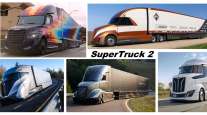Senior Reporter
NACFE Identifies Priority Regions for EV Deployments

[Stay on top of transportation news: Get TTNews in your inbox.]
The United States has five high-priority areas where the regional haul environment is inherently so well suited for moving freight economically with electric vehicles that fleet owners there should plan to deploy those trucks “even if just as a pilot project,” according to the North American Council for Freight Efficiency.
The five locations NACFE identified in its new guidance report are: California, Texas’ four largest urban centers, the Northwest, the Rocky Mountain front range and the Northeast.
NACFE found the areas share some key traits, including relatively mild weather, lower electricity prices, high levels of freight movement, a pressing need to improve air quality and supportive policies and incentives.
NACFE RMI RegionsReport 1 by Transport Topics on Scribd
The report, “Potential Regions for Electric Truck Deployments,” proposed a framework to help prioritize the necessary steps in regions where electric truck deployments make the most sense and are likely to be the most successful. Completed in conjunction with the Rocky Mountain Institute, the report emerged from large national fleets seeking more information on deployment options.
“The regional haul day cab is such a large fertile ground for electric trucks on dedicated routes [within 300 miles]. That’s where we think the focus should be to really help scale,” Mike Roeth, executive director of NACFE, said during a virtual press conference.
The report’s detailed framework is grounded on:
- Technology — identifying the regions that are most favorable to the unique attributes of the technology itself.
- Need — identifying the regions that exhibit the greatest need for the technology.
- Support — identifying the regions that provide the most support for the technology.
“We think this framework will help us bring the priorities up to help us through that time period where it is very difficult to justify electric truck production and purchases if the up-front cost of both the charging infrastructure and trucks are so high,” Roeth added.
NACFE Newsletter – August 2020 - https://t.co/txXeqAuTLG
NACFE Releases Guidance Report on High Potential Regions for Electric Truck Deployments pic.twitter.com/Lei4fiJsVN — Michael D Roeth (@mikeroeth) August 25, 2020
Other key findings:
- Many trucking operations are not confined to individual states, and as such, fleets should think about electric vehicle deployments at the regional level.
- Policies and incentives to support electric truck adoption vary drastically by region.
- Policymakers and advocates looking to increase adoption of medium- and heavy-duty vehicles in their regions should consider which of the framework criteria they can change.
- As the technology develops further, we expect even more regions to favor electric trucks.
- Fleets should work with policymakers, regulators, utilities and other stakeholders in their region to collaboratively develop strategies to advance zero-emission trucks.
NACFE has been very aggressive in working with utilities, and national and regional utility associations, Roeth said.
“You could see it in their eyes or you can feel it over Zoom that they were like ‘electric trucks, I won’t have to worry about that; that’s so far out in the future,’ ” he said. “But now they are saying, ‘Maybe it’s coming. Well, wait a minute, that could be a big opportunity for us. So let’s look at it now.’ ”
Want more news? Listen to today's daily briefing:
Subscribe: Apple Podcasts | Spotify | Amazon Alexa | Google Assistant | More




